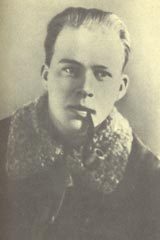
سنگِ آبیرنگ مثل زغال، داغ بود و روی سطح صافش کلماتی نوشته شده بود، اما گلولای آنها را پوشانده بود. ایواشکا فوری فهمید که این سنگ سحرآمیز است. کفشش را درآورد و با پاشنهاش تندتند زد روی گلولای تا زودتر آن کلمات را بخواند. این نوشتهای بود که او خواند: کسی که این سنگ را به کوه ببرد و آنجا آن را تکهتکه کند، جوانی خود را بازخواهد یافت و زندگی را از نو آغاز خواهد کرد. این مجموعه شامل ۱۰ داستان شگفتانگیز است و هر داستان تلاش میکند بچهها را به دل طبیعت ببرد و شگفتی و جادوی آن را به آنها نشان دهد. چاپ اول ۱۴۰۳
Authors


Arkadi Petrovich Golikov, better known as Arkadiy Gaidar (Russian: Аркадий Гайдар), was a Soviet writer, whose stories were very popular among Soviet children. He was born in Lgov town, Imperial Russia (now in Kursk Oblast, Russia), to a family of a teacher. Gaidar spent his childhood in Arzamas. In August of 1918 Gaidar became a member of the Bolsheviks, volunteering for the Red Army in December of that year, still aged only 14. During the Russian Civil War, at the age of 16 he became commander of a regiment. He participated in the suppression of several anti-communist uprisings, among them the Antonovshchina uprising. As a boy of 18, while commanding a regiment in Khakassia, he brutally dealt with the local population. Later in life he complained that the dreamed of Kalmyks that he personally hacked to death. On several occasions Gaidar was wounded in combat. In 1922, he was accused of abuse of power. Gaidar was stripped of his position and expelled from the party, and was sent for a psychiatric examination. The case ended with a diagnosis of “traumatic neurosis”. He retired from the army in 1924. His nervous illness did not leave him throughout his life, he was repeatedly treated in psychiatric clinics and had a serious drinking problem. In 1925, Gaidar began publishing his literary works. His story "RVS" (1926) defined his further life in many respects: Gaidar found his vocation in writing children's literature, telling stories of front-line camaraderie and the romanticism of the revolutionary struggle. His story "Timur and his squad" (1940) made Gaidar famous. The character Timur was named after and partially based on Gaidar's son. A captivating account of an altruistic pioneer youth gave birth to the mass Timur movement among Young Pioneers and other child organizations all over the Soviet Union. In the first days of the Great Patriotic War Gaidar was sent to the front as a special correspondent for Komsomolskaya Pravda. In the fall of 1941, Gaidar and other soldiers were surrounded by the German troops. He joined the partisans and became a machine gunner. On October 26, Gaidar died in combat. He was interred in the town of Kanev, where a monument honoring him was erected in 1953. Gaidar was awarded two orders and several medals.